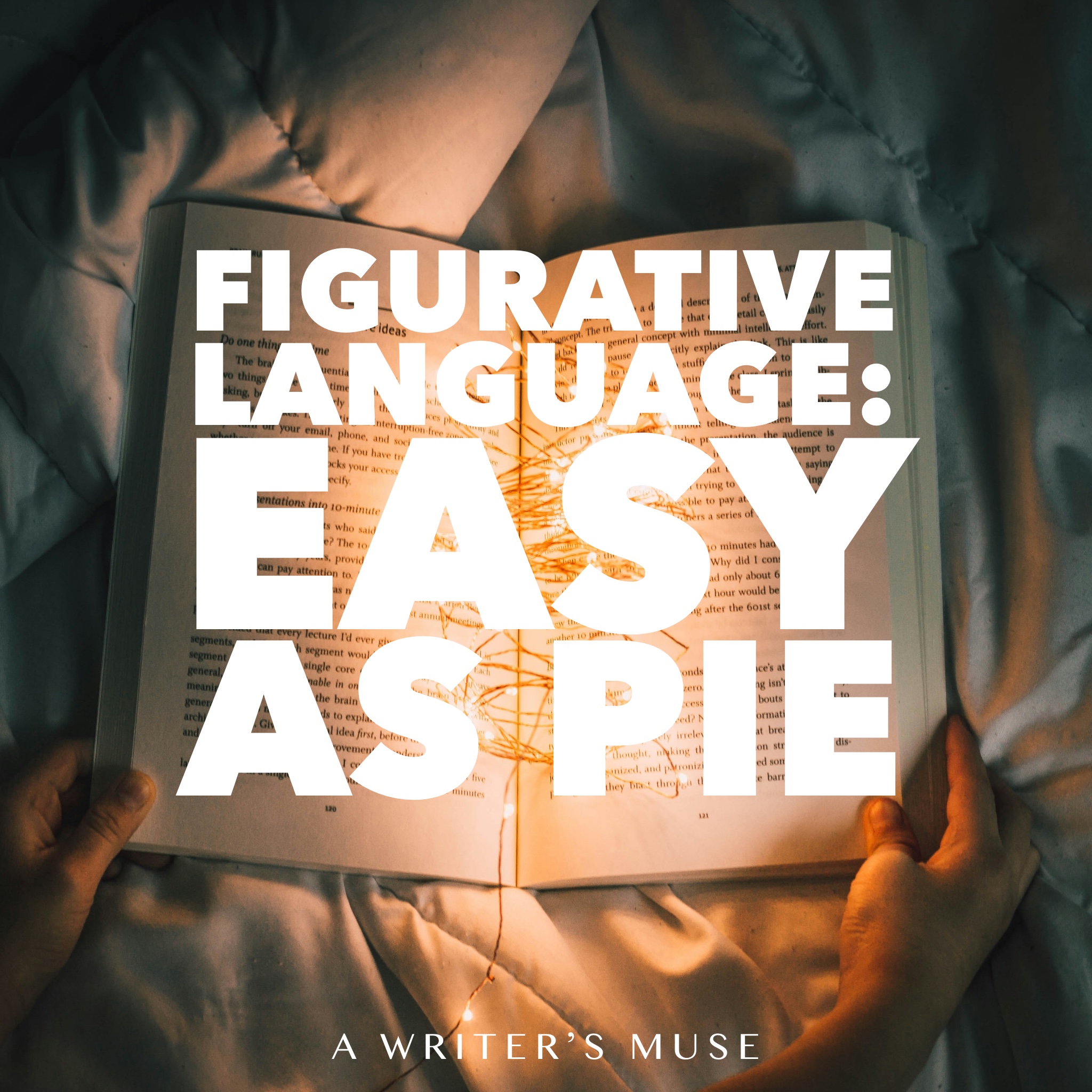We all need figurative language to express the images in our writing, whether it be fiction or nonfiction.
All to often, writers get the bad rap that we are not really creators, or even artists. But think again about how you write to create an image or screenplay in your mind.
While we all bring our own experiences and ideas to a book, our readers may miss the point of a page, chapter or book.
Words bring out a picture to a reader’s mind. If you words fail to express the image, then your reader may simply walk away with a subdued or personal image.
Plus, you may not want to overuse figurative language, but inserting it in the best places to capture the picture on your canvas only helps us communicate with our readers.
Try some of these figurative language ideas!
Simile
A simile is a figure of speech that directly compares two different things using the words “like” or “as” to create a vivid or imaginative association between them. Similes are used to enhance descriptions, convey emotions, and create imagery by highlighting similarities between two seemingly unrelated objects, concepts, or situations.
Here are a few examples of similes:
- “Her eyes sparkled like diamonds in the sunlight.”
- “He was as brave as a lion in the face of danger.”
- “The children laughed like a chorus of angels.”
- “Time flies like an arrow.”
- “The old man’s voice trembled like leaves in the wind.”
In each of these examples, the simile draws a comparison between two things using the words “like” or “as” to evoke a specific image or feeling. By likening one thing to another, similes can add depth, vividness, and poetic resonance to language, enriching the reader’s experience and imagination.
Oxymoron
An oxymoron is a figure of speech that combines two contradictory or opposite terms to create a paradoxical effect. Despite appearing contradictory, oxymorons are often used to convey complex ideas, evoke irony, or highlight the tension between conflicting concepts. Here are some examples of oxymorons:
- Jumbo shrimp
- Deafening silence
- Bittersweet
- Living dead
- Civil war
- Open secret
- Pretty ugly
- Clearly confused
Metaphor
A metaphor is a figure of speech that directly refers to one thing by mentioning another, in order to suggest a similarity between the two. Unlike a simile, which uses “like” or “as” to make a comparison, a metaphor asserts that one thing is another. Metaphors are used to convey abstract concepts, create vivid imagery, and evoke emotions by drawing parallels between seemingly unrelated objects, ideas, or experiences.
Here are a few examples of metaphors:
- “Time is a thief.”
- “The world is a stage.”
- “Her laughter was music to his ears.”
- “He’s drowning in a sea of paperwork.”
- “The city streets were a jungle of concrete and steel.”
In each of these examples, the metaphor implies a comparison between two things without explicitly stating it. Instead of saying that time is like a thief, the metaphor asserts that time is a thief, emphasizing the idea that time can steal moments or opportunities from us. Metaphors add depth, complexity, and layers of meaning to language, inviting readers to interpret and explore the connections between different concepts and experiences.
Alliteration
Alliteration is a literary device in which a series of words in a sentence or phrase have the same beginning consonant sound. It involves the repetition of consonant sounds, particularly at the beginning of words, to create a rhythmic and memorable effect. Alliteration is commonly used in poetry, prose, slogans, and advertising to add emphasis, create mood, or enhance the musicality of language.
Here are a few examples of alliteration:
- “Peter Piper picked a peck of pickled peppers.”
- “Sally sells seashells by the seashore.”
- “She sells sea shells down by the sea shore.”
- “Galloping through the green grass.”
- “The big, blue balloon bobbed in the breeze.”
In each of these examples, the repetition of the initial consonant sound (such as the “p” sound in “Peter Piper” or the “s” sound in “Sally sells seashells”) creates a sense of rhythm and unity within the sentence or phrase. Alliteration can contribute to the overall tone and atmosphere of a piece of writing, making it more engaging and memorable for the reader.
Idiom
n idiom is a phrase or expression that has a figurative meaning that is different from the literal meaning of the individual words. Idioms are often culturally specific and may not make sense when interpreted literally. Instead, they convey a particular message or idea that is understood by speakers of a particular language or community.
Idioms can be colorful, humorous, or poetic, and they are commonly used in both spoken and written language. They serve to add richness and nuance to communication, allowing speakers to express themselves in creative and evocative ways. Here are some examples of idioms:
- Break the ice: To initiate conversation or alleviate tension in a social situation.
- Cost an arm and a leg: To be very expensive.
- Hit the nail on the head: To describe something accurately or precisely.
- Piece of cake: Something that is very easy to do.
- Bite the bullet: To endure a painful or difficult situation with courage.
- Kick the bucket: To die.
- Under the weather: To feel unwell or sick.
- Burn the midnight oil: To work late into the night.
- Cry over spilled milk: To lament something that has already happened and cannot be changed.
- Let the cat out of the bag: To reveal a secret.
Onomatopeia
Onomatopoeia is a literary device in which a word’s pronunciation imitates the sound it represents. Essentially, it’s when a word sounds like the noise it is describing. Onomatopoeic words are often used in literature, poetry, and everyday language to evoke sensory experiences and create vivid imagery.
Here are some examples of onomatopoeia:
- “Buzz” – the sound of a bee
- “Boom” – the sound of an explosion
- “Hiss” – the sound of a snake
- “Cuckoo” – the sound of a bird
- “Splash” – the sound of water hitting a surface
- “Crunch” – the sound of something being crushed or bitten
- “Whisper” – the soft sound of speaking quietly
- “Tick-tock” – the sound of a clock
- “Moo” – the sound of a cow
- “Sizzle” – the sound of food cooking in hot oil or on a grill
By using onomatopoeia, writers can create aural imagery that engages the reader’s senses and brings scenes to life with vivid sound effects.
Hyperbole
A hyperbole is a figure of speech in which exaggeration is used for emphasis or effect. It involves the deliberate exaggeration of a statement or description for rhetorical purposes, often to make a point, create humor, or emphasize a particular quality or characteristic.
Here are some examples of hyperbole:
- “I’m so hungry I could eat a horse.”
- “She’s as tall as a skyscraper.”
- “I’ve told you a million times.”
- “This bag weighs a ton.”
- “I’m so tired I could sleep for a year.”
- “His smile was as bright as the sun.”
- “It’s raining cats and dogs.”
- “I’m so busy I don’t have a spare minute.”
- “This book is as thick as a brick.”
- “I’m as old as the hills.”
In each of these examples, the speaker uses exaggerated language to make a point or convey a feeling. Hyperbole adds emphasis, humor, or drama to language, allowing speakers and writers to express themselves in colorful and memorable ways.
Personification
Personification is a literary device in which human qualities, characteristics, or actions are attributed to non-human entities or objects. Essentially, it involves treating something that is not human as if it were human, giving it human-like traits, emotions, or behaviors. Personification is often used in literature, poetry, and storytelling to make descriptions more vivid, engaging, and relatable.
Here are some examples of personification:
- “The wind whispered through the trees.”
- “The sun smiled down on the children playing in the park.”
- “The flowers danced in the breeze.”
- “The waves kissed the shore.”
- “Time flies when you’re having fun.”
- “The stars winked at me from the night sky.”
- “The old house groaned as if in pain.”
- “The thunder growled in the distance.”
- “The car engine coughed and sputtered.”
- “The fire crackled and roared.”
In each of these examples, non-human entities or objects (such as the wind, sun, flowers, waves, time, stars, house, thunder, car engine, and fire) are described as if they possess human-like qualities or actions. Personification adds depth, imagery, and emotional resonance to writing, allowing readers to connect more deeply with the subject matter.
Cliche
A cliché is an overused phrase, expression, or idea that has lost its originality, impact, or effectiveness due to its frequent repetition. Clichés often stem from common sayings, idioms, or themes that become trite or stereotypical through excessive usage. While clichés may have once been fresh and meaningful, their constant repetition has rendered them clichéd, and they can come across as unoriginal or uninspired in writing or conversation.
Clichés can manifest in various forms, including:
- Phrases: Such as “easy as pie,” “time heals all wounds,” or “the apple doesn’t fall far from the tree.”
- Scenarios: Like the “hero saves the day” trope or the “love at first sight” storyline.
- Character Archetypes: Such as the “wise old mentor” or the “damsel in distress.”
- Settings: Like the “dark and stormy night” or the “tavern full of rough characters.”
Irony
Irony is a literary device or rhetorical device characterized by a contrast between what is expected and what actually occurs, or between what is said and what is meant. It involves using language in a way that implies the opposite of the literal meaning, often for humorous, dramatic, or satirical effect. Irony relies on the reader or listener recognizing the incongruity between appearance and reality, expectation and outcome, or statement and intention.
There are several types of irony:
- Verbal Irony: This occurs when a speaker says one thing but means the opposite, often to express sarcasm or make a point. For example, saying “What a lovely day!” during a thunderstorm.
- Situation Irony: This occurs when the outcome of a situation is contrary to what is expected. For example, a fire station burning down.
- Dramatic Irony: This occurs when the audience knows something that the characters do not, leading to tension or suspense. For example, in a play, the audience knows that a character’s friend is planning to betray them, but the character remains unaware.
- Situational Irony: This occurs when the outcome of a situation is the opposite of what was expected. For example, a lifeguard drowning.
Irony adds depth, complexity, and ambiguity to literature and communication, allowing writers to convey multiple layers of meaning and engage readers in thought-provoking ways.
In conclusion, ask yourself this
If you seek to communicate with your readership, I mean really communicate, what do you want to say?
If you took a picture of what you said, would it be what you intended or pictured in your mind?
Inserting figurative language into your stories and even your nonfiction works only enhances imagery and communication.
Plus, it creates an enjoyable reading, no matter what the subject matter!
But, should we use it in all of our sentences? Well, probably not. For example, I could include a bit of irony, personification and a cliche all in one paragraph. But, that might be a bit over-kill.
Figurative language has a place in our nonfiction and fiction writing, however, using your descriptions fastidiously creates a greater impact on your readers.

